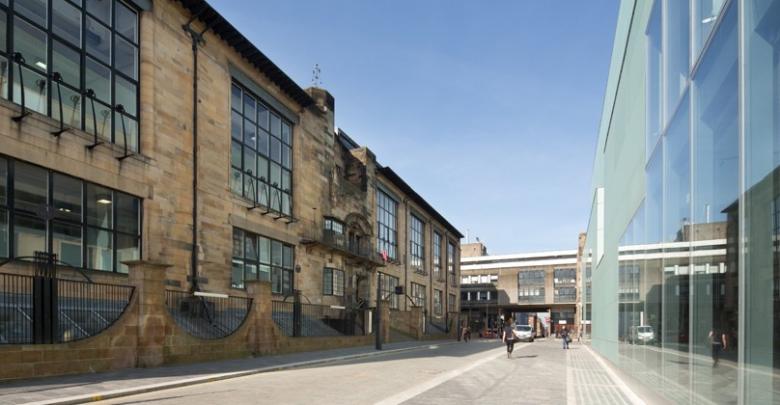Dismantling – and Rebuilding – the Mackintosh Building
John Hill
11. July 2018
Glasgow School of Art's Mackintosh Building before its June fire (Photo courtesy of Glasgow School of Art)
A new statement from the Glasgow School of Art documents the dismantling of Charles Rennie Mackintosh's masterpiece damaged in a fire last month, while the Guardian quotes the GSA director's determination to rebuild.
Just two weeks after fire swept through the Mackintosh Building – its second fire in four years – the GSA announced that portions of the building required urgent dismantling. Yesterday's announcement from the GSA details the start of the weeks-long dismantling (excerpt here, with full transcipt at bottom):
GSA Director Tom Inns told the Guardian, in his first interview since the fire:The Contractor is starting today to reduce the height of the high level walls on the south side of the building, carefully taking down damaged and unstable masonry. With the machinery brought to site the Contractor can work on several ‘fronts’, so after a start today in the middle of the south façade, we will quickly move on to reducing height to the top parts of the south-east corner and east façade. Work will then follow on the west end and then parts of north façade.
To date, with the investigation by the Scottish fire and rescue service ongoing, the cause of the second fire in four years is still unknown.We’re going to rebuild the Mackintosh building. There’s been a huge amount of speculation about what should happen with the site and quite rightly so, but from our point of view and that of the city of Glasgow, it is critically important that the building comes back as the Mackintosh building.
7/10 NEWS RELEASE: Work begins to dismantle dangerous sections of the Mackintosh Building
Work has begun to dismantle dangerous sections of the Mackintosh Building today, 10 July 2018. The work will be done to a methodology developed by expert structural engineers, Glasgow-based David Narro Associates, and GSA contractor, Coatbridge-based Reigart. The methodology has been shared with Glasgow City Council Building Standards, who worked with the GSA throughout the development, and with Historic Environment Scotland .
“The primary aim of the initial works is to make the building safe and structurally stable,” says Dominic Echlin of David Narro Associates. “It is important to understand that our agreed approach is the safest way to dismantle the dangerous elements of the building and, importantly, ensure there is no damage to nearby properties or risk to those working on site.”
“The Contractor is starting today to reduce the height of the high level walls on the south side of the building, carefully taking down damaged and unstable masonry. With the machinery brought to site the Contractor can work on several ‘fronts’, so after a start today in the middle of the south façade, we will quickly move on to reducing height to the top parts of the south-east corner and east façade. Work will then follow on the west end and then parts of north façade.,” he adds.“This sequence has been determined so we keep the building as stable as possible and the dismantling controlled throughout the process.”
The work will be undertaken using manual dismantling of the masonry, which will be accessed by a combination of Mobile Elevated Working Platforms (MEWP) and crane hoists. It will be carried out as a controlled dismantling by Reigart. The main crane, which was brought up to Glasgow from Sheffield, is positioned in Sauchiehall Street at the junction with Dalhousie Street and it is hoped to position a second crane at the junction of Sauchiehall Street and Scott Street. Three further cranes will be used for the work. These will be positioned on Renfrew Street, one at the junction with Dalhousie Street and the other two opposite the Reid Building.
Masonry and brickwork will need to be dismantled in a controlled manner, brick by brick, block by block with heavier high level stonework removed and transferred via hoists which will then be lowered down to street level for sorting and storage off site. Where possible and safer to do so, plainer areas of facades will be lowered into the site for later removal. This permits the work to proceed swiftly and with minimum danger to surrounding properties. Protection will be provided to adjoining properties as necessary during the down taking elements of the work.
The work is expected to take several weeks, but as the various phases are completed Glasgow City Council Building Standards will assess whether it is possible to reduce the size of the exclusion cordon.
Related articles
-
Glasgow School of Art to Be Dismantled
on 6/28/18
